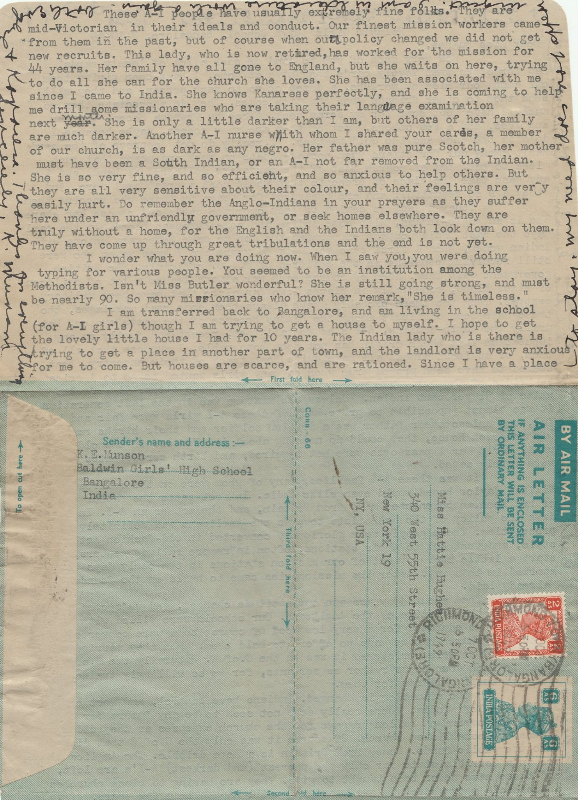How were Anglo-Indians perceived just after the Indian independence? A friend on facebook recently shared two sides of an old postcard written by a missionary in 1949 by a missionary KE Munson to a friend of hers in the USA. I was fascinated by the postcard, her opinions and since it’s so difficult to read, transcripted it here for history geeks like me. Read, enjoy, feel free to share! 🙂
From: K.E.Munson, Baldwin Girl’s High School, Bangalore 7-10-1949
To: Miss Hatte Hughes, New York, USA.
Dear Miss Hughes,
How very good of you to send me such a lot of lovely cards. I had forgotten what lovely cards they have at home. I have been giving them out among our mission workers, a dozen or so to each person and they will send them to other friends when the time comes. The do appreciate them so much.
I have kept some for my scrap book, those by Grandma Moses, Currier and Ives, and a few others. Most of them are snow scenes, maybe because I do miss the snow and the cold weather. I really do not approve of the card habit among our Christians when postage costs so much and means that much less to eat. But of course most of the cards are delivered by hand, and in any case take the place of presents that would cost a great deal more. And they are so beautiful, and are treasured for years by those who receive them.
Today a lady is coming to look over the cards and choose her share.
She’s an Anglo-Indian, with some Indian and some European blood. In the early days the East India Company encouraged the men to make temporary unions with Indian women. When I first came to India 30 years ago I knew women who were still receiving pensions as the children of E.I.C officials. The British government paid them. Then of course each war always leaves a lot of children of mixed blood, especially in places like Bangalore that have been military centres. Then too there probably have always been some real marriages, though these have ben difficult among the Hindus because of the caste system.
Naturally the Anglo-Indians, A-I’s as we call them, resent – and justly so – any imputation that their origin has not been honourable.
I suppose that all of them, or at least almost all have quite lost track of their ancestry. That seemed to have been proved true when so many girls wanted to go to America as brides of the G.I. They had to prove that they were either 51 per cent white or 51 per cent Indian as Indians and English had a quota system then. Unless the mixture was in the last generation it was almost impossible to prove. Most of these A-I girls were fair and beautiful, but unless their father was a British soldier and their births registered in Somerset House, they could do nothing about it. You see in the old days, until World War I, passports were not required and birth certificates were rarely saved.
It was these A-I families, many of whom were on the railroad, that William Taylor hoped would evangelize India.
Continue reading “Bangalore history: A 1949 letter by a missionary on anglo-Indians”

